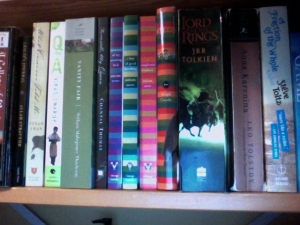 I have written about Still Life with June by Darren Greer in a previous post. As you may already know, I love this book and Darren Greer is my male author crush. He even posted a comment about that post! Definitely made me day.
I have written about Still Life with June by Darren Greer in a previous post. As you may already know, I love this book and Darren Greer is my male author crush. He even posted a comment about that post! Definitely made me day.
This is what you would call a ‘gem’ of a book. It is a delicious find but is easily lost amongst the Dan Brown’s of the world — sadly — even if it was the winner of the 2004 ReLit Award, shortlisted for the 2003 Pearson Canada Readers’ Choice Book Award and was named one of the Top 10 books of 2003 by NOW Magazine. I only happened upon it because I wanted to prepare for an internship. And I am so glad I choose this one amongst the many others.
The main character is Cameron Dodds, a struggling/washed up writer working at a Salvation Army Treatment Centre where he basically steals the lives of patients for writing material. He becomes obsessed with one particular patient, Darrel Green (a shout out to the author, perhaps?) who hanged himself earlier that year. He immerses himself into Darrel’s past, and eventually visits his sister June, who has Downs Syndrome, and embarks on the first meaningful relationship of his life; a relationship that finally forces him to stop running from reality.
My own summary does not do this book justice, and is possibly a little too melodramatic. The problem in describing this book is that it isn’t necessarily the plot that grabs you — although it does add to its greatness — it’s the character’s voice, the writing. I have never read a character like this before, and I have never been grabbed by a character so quickly. Cameron Dodds is addicting. The book is comprised of several short chapters, each presenting short snippets of Cameron’s life written in a journal entry style. I love short chapters, it makes the book read faster.
This is actually the part that truly sold me:
VII
Re: my cat.
Shortly after I got her, I found myself wishing what everyone who owns a pet and isn’t entirely happy with the world wishes occasionally: that I could be her. Just for a day — to lie around my apartment and glory in my sloth, without having to wonder who I am or what my life is about. I wouldn’t have to worry about God. Dogs may see their owners as gods of sorts, but don’t fool yourself about cats. They see us as nothing more than elaborate feeding mechanisms and mobile heat radiators.
I have often wanted to be my pet.
The publisher recently made a book trailer for Still Life with June, and it is one of the few book trailers I actually like. I think they captured Cameron and the feel of the book really well.
My love of this book led me to read his first published novel Tyler’s Cape (review still to come). It was completely opposite to Still Life with June, which was both a little disappointing and a huge relief. Even in a completely different writing style, Darren Greer still amazed me therefore cementing his title as my male author crush.





